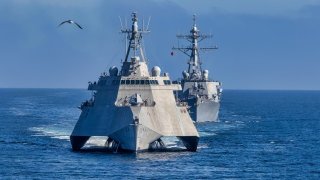The U.S. Navy's Independence-Class Littoral Combat Ship Was a Nightmare
In the early 2000s, the U.S. Navy sought to adapt to the rapid-response needs of the Global War on Terror by introducing the Littoral Combat Ship (LCS) program, which included the Freedom and Independence classes.
Summary and Key Points: In the early 2000s, the U.S. Navy sought to adapt to the rapid-response needs of the Global War on Terror by introducing the Littoral Combat Ship (LCS) program, which included the Freedom and Independence classes.
-These ships featured modular designs and advanced automation to reduce crew sizes and costs. However, the program faced significant issues, including budget overruns, delays, and failures in developing modular mission sets. Maintenance costs soared as the Navy relied on contractors, diminishing ship readiness. The Independence-class, in particular, suffered from hull cracking under stress, limiting their operational speed.
-Despite initial hopes, the LCS proved unsuitable for their intended roles. Consequently, the Navy plans to retire nine of the 35 ships built. The program's primary benefit was serving as a test bed for new technologies, informing future designs like the FFG(X) Constellation-class frigates.
Independence-Class Littoral Combat Ship: From High Hopes to Hull Cracks
In the early 2000s, the U.S. Navy was pivoting its focus away from great power competition. Its new focus, and indeed that of the U.S. military as a whole, went toward the rapid-response, small-scale operations that characterized the Global War on Terror.
Adding to the Navy’s challenges was the need to maintain a reasonable fleet size. Older ships were decommissioned, and expensive new developments had yet to mature.
The Navy thought it had found an answer in the Littoral Combat Ship, a new class of vessel designed for high-speed coastal interdiction operations in littoral waters. But the LCS ended up falling well short of their promise.
What Made It Attractive
The LCS program involves two different designs: the steel-hulled Freedom class designed by Lockheed Martin, and the aluminum-hulled Independence class from General Dynamics. The Independence-class boats are some of the most striking warships in the seas, with a trimaran hull and a sharp, pointed bow. Both classes were built around a modular design, allowing the Navy to swap out different mission packages. It was thought that this method would be more efficient than developing ships intended for single uses or large enough to fill multiple roles.
Thanks to the inclusion of new automated technologies, the Navy could reduce crew size to just 40, as opposed to the approximately 350-strong crew on an Arleigh-Burke-class destroyer.
One of the final draws of the Littoral Combat Ship was its shallow draft and high speed. As the Navy pivoted from peer competition, the Independence and Freedom were expected to operate with large fleets, but also as standalone presences in coastal regions.
Failings
Major lobbying efforts by industry helped keep the program afloat in the early 2000s, but its issues swiftly became apparent. Both vessels were late and over budget. The Independences ended up costing about $500 million per ship.
One of the biggest issues was the failure to get the modular mission sets working. Initially, the Navy hoped the LCS would be able to fill roles in anti-submarine, mine countermeasure, and anti-surface warfare. Nearly every module was plagued with problems from the start. Furthermore, the cost and logistics required to transport and install the modules proved far higher than expected. Maintenance also incurred much higher costs than expected as the Navy relied heavily on contractors to carry out important work. This diminished the readiness of the ships, as their own crews couldn’t perform certain work on them.
Perhaps the most serious issue to plague the Independence-class emerged in 2022: their hulls were cracking under stress. Several LCS were limited to operating at 15 knots in sea state four. This restriction caps their speed at less than half the maximum, and in fairly common conditions. One of the only useful missions the Navy has conjured up for these vessels is drug interdiction, but with these speed limitations they may be unable to fulfill even that role.
The Fate of the Ships
Nearly two decades later, it appears the Navy has finally realized the failure of these ships. Over the next few years, leaders plan to retire nine of the 35 ships built, some only a few years after they have entered service.
Perhaps the only good to come of these ships was their service as test beds for emerging technologies. As the Navy works on the FFG(X) Constellation class of new frigates, many lessons learned from the Littoral Combat Ships will be incorporated into that design.
About the Author: Defense Expert Maya Carlin
Maya Carlin, National Security Writer with The National Interest, is an analyst with the Center for Security Policy and a former Anna Sobol Levy Fellow at IDC Herzliya in Israel. She has by-lines in many publications, including The National Interest, Jerusalem Post, and Times of Israel. You can follow her on Twitter: @MayaCarlin.
Image Credit: Creative Commons.


